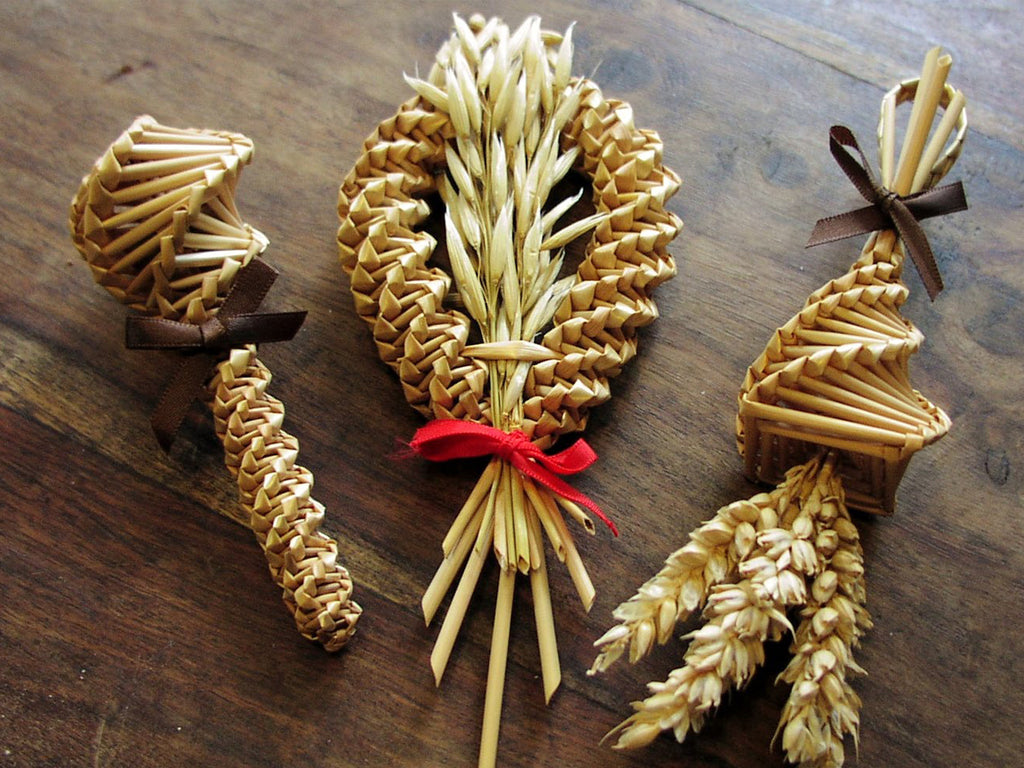
Hello Dolly

Seventy years ago, in 1951, several displays at the Festival of Britain featured large, corn dolly style sculptures made by Essex straw craftsman Fred Mizen. A series of smaller works hung in a section of the Country Pavilion devoted to rural crafts. Downstream, in the imaginative wonderland of the Lion and Unicorn Pavilion, two towering straw beasts greeted visitors. As the guide put it, they served to symbolise national character: ‘on the one hand, realism and strength, on the other, fantasy, independence and imagination.’
Mizen himself was a familiar name in strawcraft circles. Collector of twentieth century craft, Muriel Rose, had included examples of his dollies in British Council exhibitions that toured abroad during the 1940s and 1950s. Rose also worked for the Rural Industries Bureau and knew all the bestknown makers. With Mizen’s Festival contributions so prominent in displays of international significance, the art of the humble corn dolly appeared to be going global. However, after the Festival site was rapidly dismantled, these same strawcraft skills fell subject to increased criticism, and corn dolly making was once again relegated to the fringe.

In 1968, the Rural Industries Bureau published a guide to country workshops, catering to those keen to visit makers at work. The volume included the ‘corn dolly maker’, seemingly affirming the place of such creations within the traditional craft canon. Not everyone approved. In tones of condescending disdain, folklorist Margaret Dean-Smith wrote to the journal Folklore to share her displeasure: ‘... corn-dollies are not a “craft”, to be equated with thatching, carving, saddlery and other essential skills. The “corn dolly maker” is an upstart (dare one say it?) recently come into being’. It is perhaps hard to imagine why decorative strawcraft might elicit such an angry response. But, helpfully, her letter offered various clues to the source of her irritation.
Her first complaint centred on the misguided notion that, whereas other crafts were grounded in practical trades, corn dollies lacked real-world purpose. In actual fact, the skills stemmed directly from applied working contexts. Even before we consider the possibility of calendar customs, the techniques involved had been harvested from the straw-plaiting industry, decorative thatch work, hayrick finials, straw rope making, and the binding of sheaves. In short, the skills demonstrated by makers like Mizen were gleaned from established and substantial craft traditions.

Dean-Smith’s second grievance was that corn dollies were a recent invention, lacking the deeper history often attributed to them. It seems odd that someone steeped in arts and crafts as she was should take a dim view of attempts to revive the making of things that had been more common in pre-industrial times. This was folk revivalism at its finest, with practitioners basing their dollies on sketches, photos, or replicas produced to order for fin de siècle antiquarians or interwar folk collectors. Indeed, many seemingly ‘genuine’ corn dollies were just as manufactured or contrived as the whimsical ideas applied to them. Furthermore, the fact that Mizen’s Festival pieces didn’t replicate traditional forms did not mean they could not still signify continuity of creativity, playfulness, and seasonality. Despite Dean-Smith’s qualms, this mutability of form and meaning was almost certainly true of the deeper past as well…
Hello Dolly: The Highs and Lows of the Corn Dolly was written by Dr Ollie Douglas. Illustrations by Alice Pattullo.
Excerpt from our current issue, Issue 101 Grow. Find out how to read the rest of the article here.
